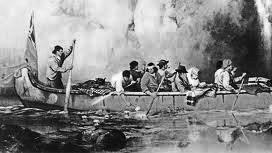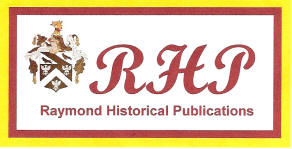|
|
|
Last time: In our time travel to the 1761 issuance of the Cambridge Patent, 250 years ago this year, we stepped back over five centuries to the Pre-Columbian Northeast and the first contacts between strangers. Chapter VIII: 450 Years Ago, 1561, The Age of Exploration After the first footfalls by Europeans along the North American coastline in the late 15th century, who were the initial Caucasians to visit the Cambridge District, and precisely when? One must largely speculate as the record’s a bit thin. The natives had no written language and their oral traditions could be vague or precise or even embellished, while the first white explorers of the vast inland stretches merely strived to survive with little time, lettering, or even inclination for journal entries. However, according to Amos Moscrip in his authoritative 1941 treatise Old Cambridge District, and from other sources today, some 220 years before the Cambridge Patent was inked, around 1540 French explorers appeared along the waterways of our region, including Jean Fonteneau dit Alfonse. Cambridge lies at the heart of a then-theorized path at least as early as 1524 that intrigued Europeans looking for a Northwest short cut to Asia. That year a voyage along the East Coast up the Gulf Stream was piloted by Florentine Giovanni da Verrazzano who may have been accompanied by one Jacques Cartier, a Breton. When Brittany united with France in 1534, Cartier was charged by his new King to return to the hemisphere and he eventually made three trips into the interior. He sailed up the St. Lawrence River that year and again in 1535-36, seeking a through route to the “Southern Sea.” Both times, though, disease and severe winters drove the explorers home. Other French ventured down into our district c.1540 and discovered a deep river channel that bore to the south, which they named La Grande Riviere (the Hudson.) In 1541, with plans then only to colonize, Cartier led five ships to Kanata, a First Nations word for “land” or “settlement” as applied to the region by the Europeans. While the locals helped the strangers survive the ordeals of the first two treks, they were less engaging this time after the French abandoned their search for a way west, seeking instead whatever local riches they could abscond with. Evidence? Around vegetable gardens and cow pens, they built forts stocked with cannon and demanded to know where the gold was.
In 1542-43, on
the heels of Cartier’s last
voyage, Alfonse
led a crew of 200,
including prisoners and a few women, to
expand the colony, but
again the effort was abandoned after yet another frigid winter.
However, not before a party ventured to the south apparently after
hearing of plentiful beaver
What’s the legacy today of Jean Fonteneau dit Alfonse in the Cambridge District, likely the first white man to gaze upon the valley’s natural beauty? Know that by late 1544 – not only a trader but a privateer – he was home disrupting Basque shipping despite a treaty sealed between France and Spain. When a Spanish fleet caught up with him, his career and life came to an end, evidently killed in action (some say a fate written in 1549.) Shall we erect a monument to him here in Washington County? You decide. By 1561 appetites were whetted for the fashionable furs from the Cambridge District and other waterways of America, delivered to the estates and palaces of Europe. This likely included the Court of Henry VIII in the 1550s, who just couldn’t keep a good woman in furs without losing their heads over the matter. In 1578 the earliest recorded use of the term Americans in the English language was applied to the Indians in a report about Englishman Martin Frobisher’s voyage to North America, again looking for the Orient. He brought scientific specimens back to London, including Inuits gunned down like so many seals. The next summer, 1579, a continent away Francis Drake reported heavy sleet off northern California, validating the Little Ice Age. But Drake and his crew camped peacefully among more cousins of the Mahicans, Coastal Miwoks, for five weeks preparing the Golden Hinde for a trans-Pacific crossing. They were half way around the globe raiding Spanish shipping under the commission of the late Hank’s little girl, Elizabeth I. Arrival in Plymouth two years later earned Privateer Drake the honor as history’s first sea captain to circumnavigate in a single trip. (Magellan never made it himself during his fleet’s 1519-22 pioneering voyage.)
400 YA, 1611, European Colonization In 1611 the new King James Bible was hot off the press, intended for any who could read English, since the Bishops’ Bible, the previous standard, was possessed only by the clergy, who’d read and interpret The Word for the rank and file including the explorers during their far flung adventures. The year before, 1610, marked the discovery of Jupiter’s four Galilean moons, which shook the religious and political worlds to the core while lending credence to a heliocentric scientific community. It was Galileo, the so-called father of modern science, who first gave us today’s healthy tension between faith and high technology. Reliable histories of the New World forays were now being written by pilots and their priests, by lawyers and merchants and others vested in royal charters across the seas. This we found in our old school texts, but today with a bit of revisionism from new research, archaeological sites, remote library shelves, trunks in dusty attics, not to mention a certain measure of socio-political spin. Backtracking a bit, everyone knows the USA’s oldest European settlement is at Saint Augustine, FL, occupied by the Spanish in 1565. Right? Maybe. What makes a “settlement”? Other SE locales stake earlier claims. Six years before, in 1559, a Spanish fleet of 11 ships from Vera Cruz, with 1500 sailors and settlers, Mexican craftsmen, African slaves, landed in Pensacola harbor and set up shop. But a big wet wind blew in from the Gulf within weeks, destroying eight ships and provisions. As neither the World Meteorological Organization nor FEMA were around to a) name that hurricane, or b) suffer the slings and arrows of those who pitched huts near swamps – and their carper-bagging political hacks (think Katrina) – the settlers fended for themselves yet abandoned the place by 1561. 1500 people for two years? Sounds like a settlement. Another white establishment in the present-day US that preceded St. Augustine was built by French Huguenots, escapees from Catholic persecution in France. First, in 1562, a contingent of twenty some soldiers built Charlesfort (on today’s Parris Island, SC), but abandoned it in less than a year; not much of a settlement there. They tried again in 1564, down the coast on the St. John River between present-day Jacksonville and the Atlantic, at Ft. Caroline. 200 immigrants, including women, hung on for a year until all were slaughtered by the Spanish, anxious about encroachment by the heathens. Makes for a legitimate claim for another settlement earlier than St. Augie’s; but in mainline history texts, permanent is the operative word. England next entered stage right, about the time the quill of Will Shakespeare (Francis Bacon?) was, forsooth, creating the richest of early English Lit. Beginning in the 1580s, several Crown colonies were granted business charters. In ‘86 the first Virginia Colony was set down on Roanoke Island (in later NC), Walter Raleigh, Patron. He had high hopes for certain riches, long before stark warning labels by the Surgeon General. John White, a colonist, produced artwork of the earliest known water colors featuring the natives, their customs and dress. The venture failed as the settlers retreated home for lack of the basics, only to return the next year. By ’88, however, all vessels for re-supply were tied up as England and Spain duked it out in the Channel (leaving the Armada in flames), so when relief did arrive in ‘90, the colony had vanished. Killed by the natives? Swallowed by swamps and sandbars? Who knew? Soon though, in 1607 a major milestone was set in the lower Chesapeake at Jamestown, another commercial venture and the very first surviving English outpost in America. This takes us again to 1609 and back to the north, to the Cambridge region and two parallel but separate events. The latest explorer out of France, Sammy Champlain, sailed the St. Lawrence again, once more seeking Asia. He spied a lake to the south and gave it his name despite that countrymen of decades prior had likely paddled its length to reach the Batten and Owl kills. Also that year, another Continental power took note of the region when the Dutch approached from the south. Hank Hudson, an Anglo hired by Holland, navigated his Halve Maen up the tidal wash of a 150-mile long fjord (one day to bear his name), and dropped anchor at today’s Albany. He reported back to the Orange-Nassau Court in Amsterdam that it wasn’t the way west but they could at least horn in on the beaver business the French so enjoyed. Oddly, two years later, on a new search for a NW passage, Hudson sailed into a huge bay in north Canada, but the crew mutinied and set him, his son and two others adrift in a small launch. They were never heard from again. Tough job, 17th century sea captain; tough way to pick up another place name on the map. Four centuries ago, in 1611, only the Mahicans were residents of our area while the old French and the new Dutch merely came and went to camp and collect the goods. However, in 1614 the region’s first permanent trading post, Dutch, was built at today’s Albany, the fourth oldest extant settlement in the 50 States, after FL (1565, 1559, whatever), VA (1607), and NM (1610, at Santa Fe). Tragically, in 1616, along a 30-by-200-mile swath (ME to NY) over a third of the Indians died from those Old World diseases likely brought ashore by fishermen seeking game and fresh water. Survivors fled west over the Berkshires and Taconics into our Hoosic watershed. (Recall this was four years before the Plymouth Pilgrims of 1620.) By 1622 the Owl Kill fell for the first time under European governance when New Netherland was chartered by the Suits (OK, the Robes) in Amsterdam to the Dutch West India Company, which ranged from the upper Connecticut to the lower Delaware. It would be two more years though, 1624, before the capital of New Holland was set in later-day New York harbor. One can safely state, however, that the colony’s very first government was seated at Fort Orange (Albany). At that time the new residents of New Netherland opened a new chapter that spanned a rather broad domain, one little corner of which would become known as Cambridge … in a mere one hundred and fifty years. Next time: Chapter IX: 350 Years Ago, 1661, New Netherland // 300 YA, 1711, The Great Awakening Sources include: Old Cambridge District (A. Moscrip, 1941); The Island at the Center of the World, (R. Shorto, 2005); illustration: public domain. (The author may be contacted at tmraymond4@gmail.com ) ============================================================================
CAMBRIDGE HISTORY LIVES © 2011 |


